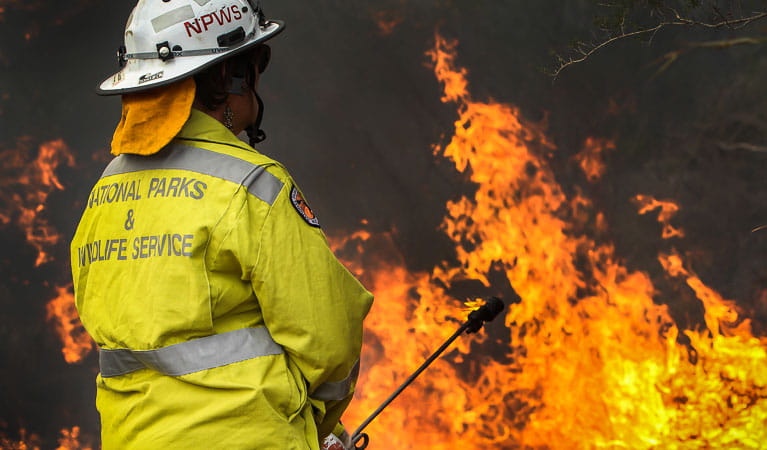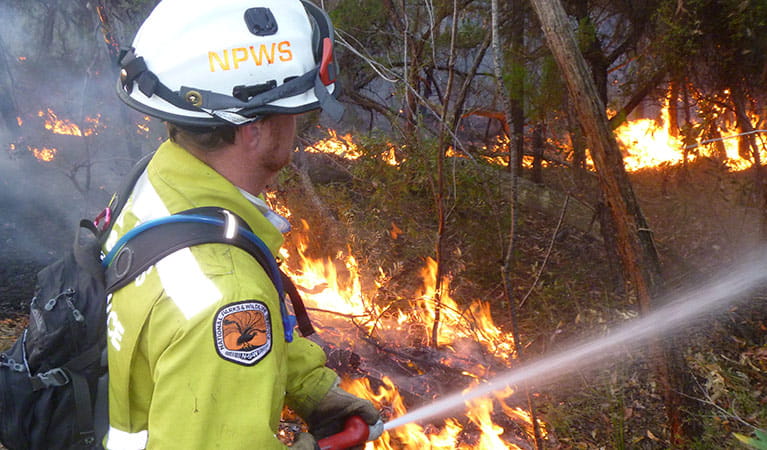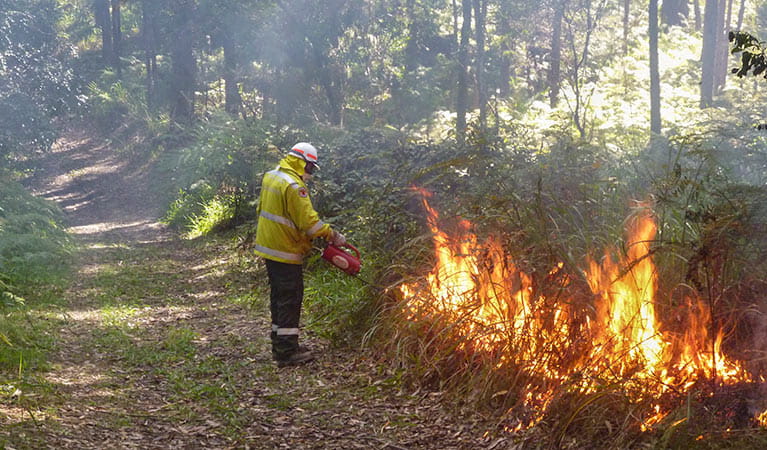Hazard reduction program
Managing fire-prone NSW national parks requires a multi-layered approach, including fire planning, community education, and fuel management. When it comes to reducing risks from fire-prone fuels, NSW National Parks and Wildlife Service (NPWS) conducts planned hazard reduction activities like mowing and controlled burning to assist in the protection of life, property and the community.
Read more about Hazard reduction program
A hazard reduction burn is a fire ignited and controlled to burn a predetermined area under specific fuel and weather conditions to attain planned fuel management outcomes. Hazard reduction burning, sometimes called controlled burning or prescribed burning, is completed in strategic areas of a park. This reduces fire-prone fuel hazards which can moderate fire behaviour and aid fire suppression efforts in the right weather conditions. However, when fires weather is severe, extreme or catastrophic, areas treated by hazard reduction burns may have limited influence on fire behaviour driven largely by the weather.
Through the Enhanced Bushfire Management Program (EBMP), NSW National Parks and Wildlife Service (NPWS) plans to treat over 135,000 hectares per year in 800 or more hazard reduction activities. In the last 5 years, more than 1000 burns were carried out by NPWS, treating more than 635,000 hectares. Achieving this is highly dependent on suitable weather conditions, given the narrow window of opportunity that exists in NSW for burning safely and effectively.
In addition to prescribed burning, the NPWS hazard reduction program includes mechanical works, such as slashing and mowing. It’s important to remember planned hazard reduction isn’t the same as back-burning, which is a fire suppression tactic used during active bushfires.
While it’s vital that prescribed burning is done for the protection of the whole community, these burns can have temporary impact on visitors through smoke, road and park closures. We keep the community updated via our Alerts page, and offer several informational videos about the hazard reduction program, including videos on capability and training, and relationships with the community.
Parks related to this program
- Blue Mountains National Park
- Blackheath area
- Katoomba area
- Southern Blue Mountains area
- Glenbrook area
- Lower Grose Valley area
- Mount Wilson area
- Kosciuszko National Park
- Kosciuszko National Park
- Thredbo-Perisher area
- Khancoban area
- Lower Snowy River area
- Selwyn area
- High Plains area
- Yarrangobilly area
- Tumut area
- Kamay Botany Bay National Park
- La Perouse area
- Kurnell area
- Yengo National Park
- Cambewarra Range Nature Reserve
- Jerrawangala National Park
- Ngambaa Nature Reserve
- Robertson Nature Reserve
- Goobang National Park
- Werakata National Park
- Victoria Park Nature Reserve
- Mann River Nature Reserve
- Barren Grounds Nature Reserve
- Hunter Wetlands National Park
- Narrawallee Creek Nature Reserve
- Yarriabini National Park
- Middle Brother National Park
- Kattang Nature Reserve
- Boorganna Nature Reserve
- Coramba Nature Reserve
- Ulidarra National Park
- Torrington State Conservation Area
- Chaelundi National Park
- Monga National Park
- Beni State Conservation Area
- Clyde River National Park
- Burning Mountain Nature Reserve
- Burragorang State Conservation Area
- Bournda National Park
- Deua National Park
- Karuah National Park
- Lake Macquarie State Conservation Area
- Cecil Hoskins Nature Reserve
- Mutawintji Historic Site
- Kanangra-Boyd National Park
- Dooragan National Park
- Queens Lake Nature Reserve
- Gardens of Stone National Park
- Oolambeyan National Park
- Macquarie Pass National Park
- Coorabakh National Park
- Boonoo Boonoo National Park
- Bindarri National Park
- Bomaderry Creek Regional Park
- The Rock Nature Reserve - Kengal Aboriginal Place
- Yanununbeyan State Conservation Area
- Moonee Beach Nature Reserve
- Tyagarah Nature Reserve
- Bald Rock National Park
- Goulburn River National Park
- Wadbilliga National Park
- Parr State Conservation Area
- Conjola National Park
- Weddin Mountains National Park
- Moore Park Nature Reserve
- Copeland Tops State Conservation Area
- Stonewoman Aboriginal Area
- Nowendoc National Park
- Muttonbird Island Nature Reserve
- Scheyville National Park
- Willandra National Park
- Cascade National Park
- Conimbla National Park
- Cocoparra National Park
- Seven Mile Beach National Park
- Willi Willi National Park
- Yerranderie Regional Park
- Saltwater National Park
- Broken Head Nature Reserve
- Limeburners Creek National Park
- Nangar National Park
- Mullion Range State Conservation Area
- Culgoa National Park
- Brunswick Heads Nature Reserve
- Little Llangothlin Nature Reserve
- Broadwater National Park
- Seaham Swamp Nature Reserve
- Kings Plains National Park
- Dunggir National Park
- Mummel Gulf National Park
- Brimbin Nature Reserve
- Lake Innes Nature Reserve
- Hartley Historic Site
- Biamanga National Park
- Munghorn Gap Nature Reserve
- Cathedral Rock National Park
- Coolah Tops National Park
- Guy Fawkes River National Park
- Dthinna Dthinnawan National Park
- Terry Hie Hie Aboriginal Area
- Everlasting Swamp National Park
- Toorale National Park
- Nadgee Nature Reserve
- Mount Imlay National Park
- Garawarra State Conservation Area
- Deriah Aboriginal Area
- Kwiambal National Park
- Goolawah National Park
- Livingstone National Park
- Mother of Ducks Lagoon Nature Reserve
- Cullendulla Creek Nature Reserve
- Bangadilly National Park
- Bargo State Conservation Area
- Nattai National Park
- Turon National Park
- Towarri National Park
- Thirlmere Lakes National Park
- Palm Grove Nature Reserve
- Wallarah National Park
- Woko National Park
- Capertee National Park
- Tallaganda National Park
- Illawarra Escarpment State Conservation Area
- Woomargama National Park
- Macquarie Nature Reserve
- Cudgen Nature Reserve
- Watagans National Park


